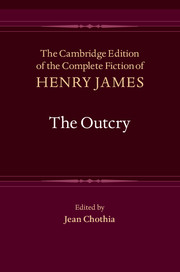Book contents
- Frontmatter
- Contents
- Illustrations
- Acknowledgments
- Abbreviations
- General Editors’ Preface
- General Chronology of James’s Life and Writings
- Introduction
- Textual Introduction
- Chronology of Composition and Production
- Bibliography
- The Outcry
- Book First
- Book Second
- Book Third
- Glossary of Foreign Words and Phrases
- Notes
- Textual Variants
- Emendations
- Appendices
Appendix B - Play and Novel: Staging and Narrative
Published online by Cambridge University Press: 11 April 2021
- Frontmatter
- Contents
- Illustrations
- Acknowledgments
- Abbreviations
- General Editors’ Preface
- General Chronology of James’s Life and Writings
- Introduction
- Textual Introduction
- Chronology of Composition and Production
- Bibliography
- The Outcry
- Book First
- Book Second
- Book Third
- Glossary of Foreign Words and Phrases
- Notes
- Textual Variants
- Emendations
- Appendices
Summary
Quotations from the novel are denoted by page number.
Quotations from the 1909 typescript of the play are denoted by act and page number.
In 1906, responding to a draft of Elizabeth Robins's Votes for Women! James advised her to move the action of the first act to ‘the big free accessible workable hall’, which would better lend itself ‘to certain verisimilitudes of movement, natural determinations of coming and going’. James's Edwardian plays consistently used such a setting: the ‘central hall high and square’ of The High Bid has ‘four important points for entrance and exit’; the ‘large sitting-room, living-room’ of The Saloon is a ‘place of general assembly’, and ‘the essence of the hall [at Bounds] for the Action’ of ‘The Other House’, ‘is its having no less than four places of entrance and exit’ (CP 555, 651, 681). The Outcry retains the settings of its originating play. The hall at Dedborough Place and Lady Sandgate's drawing room are the fixed locations of the novel: places of assembly, whose numerous doors and windows allow movement to and from inner domestic spaces and the outside world. And the reader, like the member of the audience, may hear about but is never allowed to follow the characters into those other spaces.
The stamp of the play is on the novel. The viewpoint throughout is from the front as if in a theatre and movement is directed around – and in and out of – rooms, very much as on a stage. This enables the creation of vivid visual images, like that of Grace silhouetted in a doorway, unseen by the other characters (20), and speedy departures, as when Hugh, having caught Lord John's name ‘from the inner threshold’, seeks ‘the further passage to the staircase and street’ to make his escape (90). It is also responsible for certain curious effects. We are, for example, told that Bender, having been seen approaching by Lord John, ‘was now, on the threshold of the hall, exhibited to Lord Theign as well’ (45). Theign, having stalked away from talk with Hugh, in Book Second, strolls ‘toward the other room, the threshold of which he the next moment had passed, remaining scantily within, however, and in sight of the others, not to say of ourselves; even though averted and ostensibly lost in some scrutiny that might have had for its object the great enshrined Lawrence’ (113).
- Type
- Chapter
- Information
- The Outcry , pp. 269 - 276Publisher: Cambridge University PressPrint publication year: 2016



